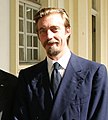Van Dyke beard

A Van Dyke (sometimes spelled Vandyke,[1] or Van Dyck[2]) is a style of facial hair named after the 17th-century Flemish painter Anthony van Dyck (1599–1641).[3][4] A Van Dyke specifically consists of any growth of both a moustache and goatee with all hair on the cheeks shaven.[3] Even this particular style, though, has many variants, including a curled moustache versus a non-curled one and a soul patch versus none. The style is sometimes called a "Charlie" after King Charles I of England, who was painted with this type of beard by van Dyck.[5] "Pike-devant" or "pickedevant" are other little-known synonyms for a Van Dyke beard.[6]
Popularity
This style of beard was popular in Europe in the 17th century.[7] It died out in Britain with the Restoration, when French styles and wigs became popular. For some time after, however, some men, known as "vow-beards", continued to wear them, vowing to wear them until the King did so again.[8] It became popular in the United States in the 19th century. Columnist Edith Sessions Tupper, of the Chicago Chronicle (1895–1908), condemned this style, along with the goatee, as indicative of a man "who was selfish, sinister, and pompous as a peacock."[4]
The style was worn by van Dyck himself and by many of the sitters for his portraits, including King Charles I of England.[3] The Russian Marxist revolutionary Vladimir Lenin also wore a Van Dyke. The Van Dyke had a revival in the 19th century[citation needed] and was worn by several well-known figures, including General Custer (among other styles) and the actor Monty Woolley. Colonel Sanders would also qualify as having a Van Dyke.
Examples
-
Ambrogio Spinola, by Michiel van Mierevelt (1609)
-
Maurice, Prince of Orange, by Michiel van Mierevelt (c. 1613-20)
-
Ferdinand II, Holy Roman Emperor, unknown artist (1614)
-
Gustavus Adolphus, attrib. Jacob Hoefnagel (1624)
-
Jacobus Arminius , by Willem Isaacsz Swanenburg (1625)
-
Charles I of England by Anthony van Dyck (1635-6)
-
Cardinal de Richelieu, by Philippe de Champaigne (c. 1642)
-
António María Esquivel (1847)
-
Self-portrait by Jean Augustin Daiwaille Dutch portrait painter (1801-1850)
-
Winfield Scott Hancock (1863)
-
George Armstrong Custer (1865)
-
Buffalo Bill (William Cody) (c. 1875)
-
Edward S. Curtis (1899)
-
Wilhelm Maybach (1900)
-
Vladimir Lenin (1920)
-
Rudolph Valentino (1924)
-
Colonel Sanders (c. 1974)
-
Pierce Brosnan (2005)
-
Christian Bale, actor (2009)
-
Johnny Depp (2011)
References
- ^ As by the OED and OED and Chambers 20th Century Dictionary; Grosswirth Marvin, The Art of Growing a Beard, p. 55, 2014, Courier Corporation, ISBN 0486797252, 9780486797250; the artist is today normally referred to as "van Dyck", though there are many variants, but when the term for the beard became popular "Van Dyke" was more common.
- ^ LIFE. Time Inc. April 24, 1939.
- ^ a b c Sherrow, Victoria (2001). For Appearance' Sake. Greenwood Publishing Group. pp. 114–115. ISBN 978-1-57356-204-1.
- ^ a b Peterkin, Allan (2001). One Thousands Beards. Arsenal Pulp Press. pp. 172–173. ISBN 978-1-55152-107-7.
- ^ Shipley, Joseph Twadell (2001). The Origins of English Words. JHU Press. p. 28. ISBN 978-0-8018-6784-2.
- ^ "pike-devant". wordnik. Retrieved 21 September 2018.
- ^ Sherrow, Victoria (2006). Encyclopedia of Hair. Greenwood Publishing Group. p. 59. ISBN 978-0-313-33145-9.
- ^ "The Westminster Review". 62 (121). Leonard Scott Publication. July 1854: 33.
{{cite journal}}: Cite journal requires|journal=(help)
External links
 Media related to Van Dyke beards at Wikimedia Commons
Media related to Van Dyke beards at Wikimedia Commons









![António María Esquivel [es] (1847)](http://upload.wikimedia.org/wikipedia/commons/thumb/a/a6/Antonio_Maria_Esquivel_portrait.jpg/93px-Antonio_Maria_Esquivel_portrait.jpg)

















